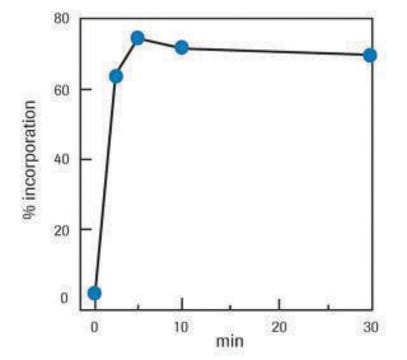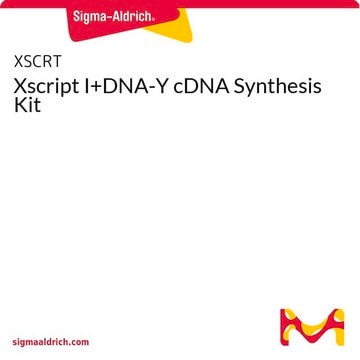11745824910
Roche
Biotin-Nick Translation Mix
suitable for hybridization, solution, sufficient for 40 labeling reactions, pkg of 160 μL
Synonim(y):
nick translation
Zaloguj sięWyświetlanie cen organizacyjnych i kontraktowych
About This Item
Kod UNSPSC:
41105500
Polecane produkty
Postać
solution
Poziom jakości
zastosowanie
sufficient for 40 labeling reactions
opakowanie
pkg of 160 μL
producent / nazwa handlowa
Roche
metody
hybridization: suitable
temp. przechowywania
−20°C
Powiązane kategorie
Opis ogólny
Convenient enzyme and nucleotide mixture.
Nick translation utilizes a combination of DNase and DNA Polymerase to nick one strand of the DNA helix, then incorporates labeled nucleotides as the polymerase examines, or "proofreads" the nicked site. The molar ratio of Biotin-16-dUTP to dTTP is adjusted to ensure that every 20th to 25th nucleotide in the newly synthesized DNA is modified with biotin. This density of haptens in the DNA yields the highest sensitivity in the immunological detection reaction.
Large plasmids, cosmids, and PCR fragments are all regularly used with this method, and the DNA can be linearized or supercoiled. Individual templates produce consistent results in the standard 90-minutes reaction, and result in an average probe length of 200 base pairs up to 500 base pairs.
Nick translation utilizes a combination of DNase and DNA Polymerase to nick one strand of the DNA helix, then incorporates labeled nucleotides as the polymerase examines, or "proofreads" the nicked site. The molar ratio of Biotin-16-dUTP to dTTP is adjusted to ensure that every 20th to 25th nucleotide in the newly synthesized DNA is modified with biotin. This density of haptens in the DNA yields the highest sensitivity in the immunological detection reaction.
Large plasmids, cosmids, and PCR fragments are all regularly used with this method, and the DNA can be linearized or supercoiled. Individual templates produce consistent results in the standard 90-minutes reaction, and result in an average probe length of 200 base pairs up to 500 base pairs.
Specyficzność
Heat inactivation: Stop the reaction by adding 1 μl 0.5 M EDTA (pH 8.0) and heating to 65 °C for 10 minutes.
Zastosowanie
For generation of highly sensitive probes for in situ hybridization labeled with Biotin-16-dUTP.
Note: The mix can also be used for filter hybridization techniques, however, for highly sensitive filter hybridization probes, we recommend that you use Biotin-High Prime from Roche Applied Science.
For nonradioactive labeling of in situ probes with other haptens, Roche Applied Science offers the DIG-Nick Translation Mix or the Nick Translation Mix.
Note: The mix can also be used for filter hybridization techniques, however, for highly sensitive filter hybridization probes, we recommend that you use Biotin-High Prime from Roche Applied Science.
For nonradioactive labeling of in situ probes with other haptens, Roche Applied Science offers the DIG-Nick Translation Mix or the Nick Translation Mix.
Jakość
Function tested in a dot blot assay.
Zasada
The nick translation method is based on the ability of DNase I to introduce randomly distributed nicks into DNA at low enzyme concentrations in the presence of MgCl2. E. coli DNA Polymerase I synthesizes DNA complementary to the intact strand in a 5′ → 3′direction using the 3′-OH termini of the nick as a primer. The 5′ → 3′ exonucleolytic activity of DNA polymerase I simultaneously removes nucleotides in the direction of synthesis. The polymerase activity sequentially replaces the removed nucleotides with isotope-labeled or hapten-labeled deoxyribonucleoside triphosphates. At low temperature (+15°C), the unlabeled DNA in the reaction is thus replaced by newly synthesized labeled DNA.
Postać fizyczna
1 vial with 5x concentrated stabilized reaction buffer in 50% glycerol (v/v) and DNA Polymerase I, DNase I, 0.25mM dATP, 0.25mM dCTP, 0.25mM dGTP, 0.17mM dTTP and 0.08mM Biotin-16-dUTP.
Uwaga dotycząca przygotowania
Assay Time: 100 minutes
Sample Materials
Supercoiled and linearized plasmid DNA
Supercoiled and linearized cosmid DNA
Purified PCR products
Note: Denaturing of the template before nick translation is not required.
Sample Materials
Supercoiled and linearized plasmid DNA
Supercoiled and linearized cosmid DNA
Purified PCR products
Note: Denaturing of the template before nick translation is not required.
Inne uwagi
For life science research only. Not for use in diagnostic procedures.
This page may contain text that has been machine translated.
Kod klasy składowania
12 - Non Combustible Liquids
Klasa zagrożenia wodnego (WGK)
WGK 1
Temperatura zapłonu (°F)
No data available
Temperatura zapłonu (°C)
No data available
Certyfikaty analizy (CoA)
Poszukaj Certyfikaty analizy (CoA), wpisując numer partii/serii produktów. Numery serii i partii można znaleźć na etykiecie produktu po słowach „seria” lub „partia”.
Masz już ten produkt?
Dokumenty związane z niedawno zakupionymi produktami zostały zamieszczone w Bibliotece dokumentów.
Klienci oglądali również te produkty
Shujun Zhou et al.
Breeding science, 64(1), 97-102 (2014-07-06)
Based on a recent hypothesis, "Five same genomes of endosperm are essential for its development in Lilium", it is expected that allotriploid lily (OTO) can be hybridized with diploid Oriental lily (OO) for introgression breeding in Lilium L.. To test
A Sepsi et al.
TAG. Theoretical and applied genetics. Theoretische und angewandte Genetik, 116(6), 825-834 (2008-01-29)
In situ hybridization (multicolor GISH and FISH) was used to characterize the genomic composition of the wheat-Thinopyrum ponticum partial amphiploid BE-1. The amphiploid is a high-protein line having resistance to leaf rust (Puccinia recondita f. sp. tritici) and powdery mildew
Cornelia E Zorca et al.
Proceedings of the National Academy of Sciences of the United States of America, 112(13), E1587-E1593 (2015-03-15)
Naive CD4 T cells differentiate into several effector lineages, which generate a stronger and more rapid response to previously encountered immunological challenges. Although effector function is a key feature of adaptive immunity, the molecular basis of this process is poorly
Kristin D Kernohan et al.
MethodsX, 1, 30-35 (2014-01-01)
Emerging studies demonstrate that three-dimensional organization of chromatin in the nucleus plays a vital role in regulating the genome. DNA fluorescent in situ hybridization (FISH) is a common molecular technique used to visualize the location of DNA sequences. The vast
Moloy T Goswami et al.
Oncotarget, 6(27), 23445-23461 (2015-07-04)
Cancer cells exhibit altered metabolism including aerobic glycolysis that channels several glycolytic intermediates into de novo purine biosynthetic pathway. We discovered increased expression of phosphoribosyl amidotransferase (PPAT) and phosphoribosylaminoimidazole carboxylase, phosphoribosylaminoimidazole succinocarboxamide synthetase (PAICS) enzymes of de novo purine biosynthetic
Nasz zespół naukowców ma doświadczenie we wszystkich obszarach badań, w tym w naukach przyrodniczych, materiałoznawstwie, syntezie chemicznej, chromatografii, analityce i wielu innych dziedzinach.
Skontaktuj się z zespołem ds. pomocy technicznej









